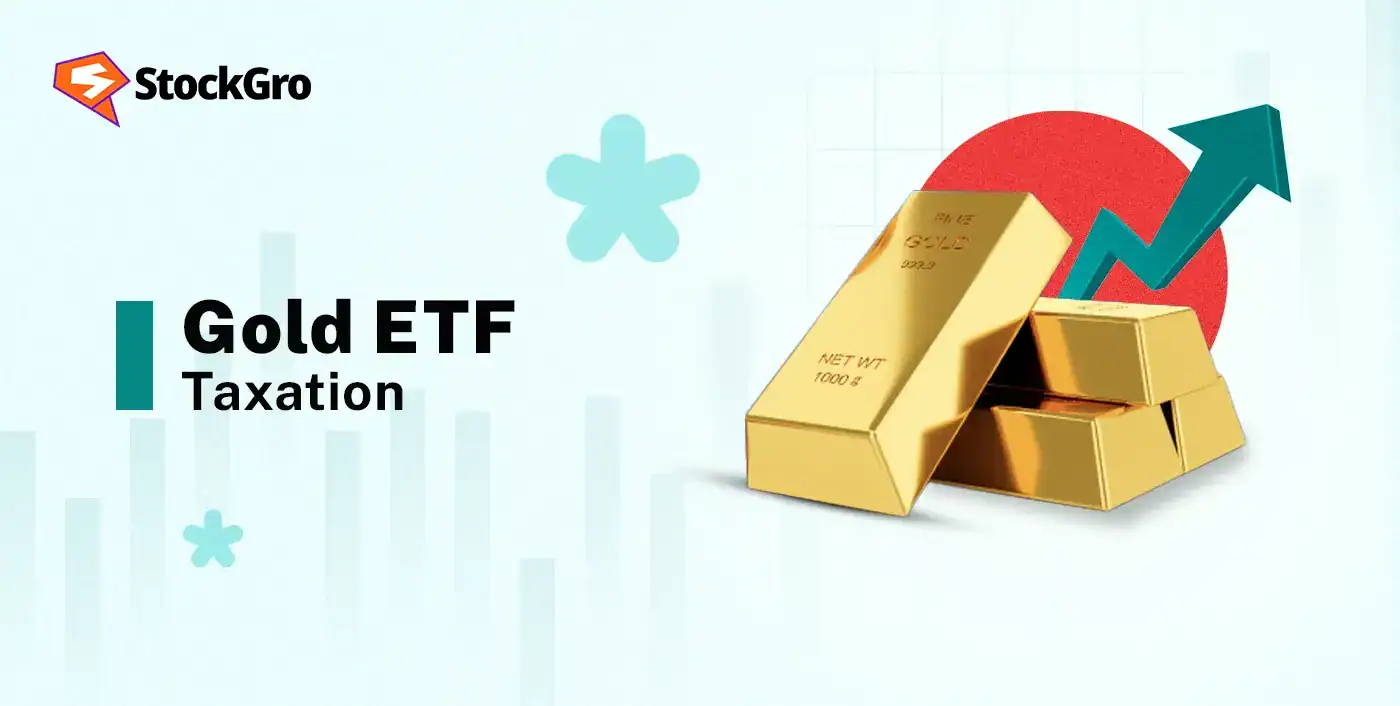
Gold has been shining brighter than ever, with prices rising over 50% in the financial year 2024-2025 and recording a CAGR of 30% over the last three years, as per MCX data. With the festive season further driving demand, investors are looking beyond traditional jewellery purchases to smarter and secure options like Gold ETFs.
A Gold ETF is basically a fund that puts its money into gold. It tracks the price of gold, and each unit of stock represents, usually, one gram of gold. These ETFs are bought and sold on the stock exchanges like other shares and stocks. It offers investing in gold without possessing physical gold.
However, understanding Gold ETF taxation in India is significant for investors to plan investments in gold and maximise post-tax returns.
In this blog, learn about how Gold ETFs are taxed based on holding period, the gold ETFs indexation benefit, and other necessary information related to taxation on ETFs in India.
What is a Gold ETF Taxation?
The taxation for gold ETFs is similar to taxation on sale of physical gold. Taxes are charged based on the holding period. If the holding period is 12 months or less, it is STCG gold ETF gains, and are taxed according to the income tax slab rates, if the holding period is more than 12 months, it is LTCG gold ETF gains, and are subject to 12.5% tax for investments over 12 months without indexation, as of 1 April 2025.
Why Taxation Matters for Gold ETFs
Taxation plays a key role in determining the actual returns from Gold ETFs. Understanding how capital gains and applicable tax rates work helps investors to plan investment properly and maximise post-tax profits. Whether it’s held for short-term or long-term, understanding taxation ensures that the investment strategy stays efficient and goal oriented.
STCG Rules for Gold ETFs in India
| Holding Period | 12 months or less |
| Rate of Tax | Income tax slabs rate |
| Taxation | Capital gains are added to total income for the financial year, and taxed accordingly |
LTCG Rules for Gold ETFs in India
| Holding Period | Over 12 months |
| Rate of Tax | 12.5% |
| Indexation | No indexation available, as per new tax rule effective from 1 April 2025 |
Indexation Explained with Example
Indexation on tax is a method used to adjust for inflation, especially for calculating long-term capital gains. It increases the original purchase price of the asset or stock to reflect its current value, while reducing the taxable amount of profit, which lowers the tax liability.
Without indexation, capital gains would be treated as nominal gains and taxed accordingly.
Indexation adjusts inflation to the original purchase price of an asset by using the Cost Inflation Index (CII), which is provided by the government every year, to calculate inflation-adjusted profit.
Let’s understand indexation and how it is calculated with an example.
Imagine an investor bought Nippon India ETF Gold BeEs worth ₹10,00,000 in April 2019 and sold them at ₹25,00,000 in February 2024.
So, without indexation, the taxable amount is supposed to be ₹15,00,000 (₹25,00,000 – ₹10,00,000) and the total tax would be ₹3,00,000. Now let’s see how indexation works:
Step 1: Cost Inflation Index (CII)
- 2019-2020 = 289
- 2022-2023 = 331
Step 2: Indexed cost of purchase
Indexed Cost = ₹10,00,000 x 363/289 = ₹11,45,328
Step 3: Taxable of long-term capital gain
Taxable Gain = ₹25,00,000 – ₹11,45,328 = ₹13,54,671
Step 4: Total tax with indexation
Tax = ₹13,54,671 x 20%(sold before 23 July 2024) = ₹2,70,934
Tax saving = ₹3,00,000 – ₹2,70,934 = ₹29,066 approximately
Recent Changes in Gold ETF Taxation (2023-25)
Before 1 April 2023:
- Short-term capital gains (STCG): For a holding period less than 3 years, tax is charged as per the income tax slab rate.
- Long-term capital gains (LTCG): For a holding period over 3 years, tax is charged at 20% with indexation.
1 April 2023 to 31 March 2025:
- Gold ETFs purchased in this period are subject to tax as per income tax slab rates, irrespective of holding period.
Post 1 April 2025 (New rule):
- Short-term capital gains (STCG): For a holding of 12 months or less, capital gains are taxed according to the income tax slab rate.
- Long-term capital gains (LTCG): For a holding period over 12 months, capital gains are taxed at flat 12.5%, with no indexation benefit.
GST, Expense Ratio & Other Costs
- GST: Gold ETFs are exempt from GST. However, physical gold is subject to 3% GST and 5% GST for making charges.
- Expense Ratio: Currently, the expense ratio on gold ETFs stands at 0.30% to 0.80%, and is subject to market fluctuation.
- Other Costs: The costs generally include brokerage fees, which are paid during the buying and selling of ETFs on stock exchanges, and tracking error, which measures how closely ETFs’ performance tracks the gold price. A low tracking error is preferable.
TDS Rules & NRI Implications
TDS rules for Non-Resident Indian (NRI) investors in Gold ETFs in India are applied differently based on whether the units are directly redeemed through the fund house or sold at stock exchanges. NRIs are exempted from investing in Sovereign Gold Bonds (SGB).
Direct redemption through fund house:
- Short-Term ETFs: 30% TDS is deducted on redemption of gold ETFs within the first two years of purchase
- Long-Term ETFs: 20% TDS is deducted on redemption of gold ETFs after two years.
Sold at stock exchanges:
In this case, no TDS is charged, but the investor is responsible for calculating and paying capital gain tax by themselves, while filing income tax returns.
Comparison: Gold ETFs vs Physical Gold Tax
| Aspect | Gold ETFs | Physical Gold tax |
| Capital Gains | STCG (12 months or less): Taxable as per income tax slab rateLTCG (more than 12 months): Taxed at flat 12.5% | STCG (24 months or less): Taxed according to income tax slab rateLTCG (more than 24 months): Taxed at flat 12.5% |
| GST | Exempted from GST | 3% on purchase of gold and 5% on making charges |
Tax-Saving Strategies for Investors
Here are some suggested strategies that investors might incorporate to save tax and maximise returns.
- Investors can invest in Sovereign Gold Bonds (SGBs), as compared to other Gold ETFs, it is not subject to tax if invested for a period of 8 years.
- Additionally, a 2.5% interest is paid to the investors annually on the initial investment, which adds an extra income besides the returns.
- Investors shall redeem or sell Gold ETFs after three years to qualify for the 12.5% long-term capital gains tax rate instead of paying the income tax slab rate, for short-term gains, which are actually higher.
Mistakes to be Avoided in Gold ETF Taxation
The following are some mistakes to be avoided in Gold ETF taxation under the new rules:
- Using old tax rates: Some investors might apply outdated rates for LTCG on Gold ETFs, which are now taxed at a flat 12.5% as of 1 April 2025
- Expecting indexation benefits: Indexation is no longer available for Gold ETFs purchased after 1 April 2025.
- Mixing up tax rules: Investors might mix Gold ETFs with physical gold or Sovereign Gold Bonds. Each has a different tax treatment.
- Ignoring expense ratio impact: Investors should compare expense ratios before investing, as even those small fees reduces profits.
Summary Table: Gold ETF Tax Rules in India
| Aspects | Short-term capital gains (STCG) | Long-term capital gains (LTCG) |
| Holding Period | Less than 12 months or 12 months | Over 12 months |
| Tax Rate | As per income tax slab rate | At flat 12.5% |
| Indexation | Not applicable | No indexation as of 1 April 2025 |
| Dividends | Added to total income and taxed accordingly | Added to total income and taxed accordingly |
Conclusion
Understanding Gold ETF taxation in India helps investors make strategic investment decisions. Investors should stay updated with the latest tax rules, expense ratios, and other costs to ensure better financial planning and higher post-tax returns.
Comparing Gold ETFs with alternatives like physical gold or other gold funds like Sovereign Gold Bonds (SGBs) could further help in achieving long-term investment goals.
FAQs
Gold ETFs in India are taxed based on the holding period. Capital gains from short-term holdings are taxed according to income tax slab rate, while long-term gains are taxed at flat 12.5% without indexation, as of 1 April 2025.
When the Gold ETFs are held for more than 12 months, the profit is considered a long-term capital gain (LTCG) and taxed at 12.5%, without indexation.
No, indexation benefit is not available in India anymore for Gold ETFs purchased on or after 1 April 2025, as per the new tax rule.
TDS applies only when NRIs redeem Gold ETF units directly through the fund house. If the units are sold on stock exchanges, no TDS is charged, but investors are required to calculate and pay tax by themselves while filing income tax returns.
The primary difference between Gold ETFs and physical gold is that Gold ETFs are exempted from GST, while on physical gold, 3% GST on purchase and 5% on making charges is charged.
In the period 1 April 2023 to 31 March 2025, capital gains from Gold ETF were taxed according to the income tax slab rate, irrespective of the holding period. However, the new tax rule, effective from 1 April 2025, reintroduced separate treatment for short-term and long-term holdings.
Yes, investors invest in Sovereign Gold Bonds (SGBs), which offer tax exemption on redemption after 8 years, along with 2.5% annual interest or invest for long-term to qualify for LTCG tax rate at 12.5%, which is relatively lower than income tax slab rates.

